History of Hoa Lu Temple
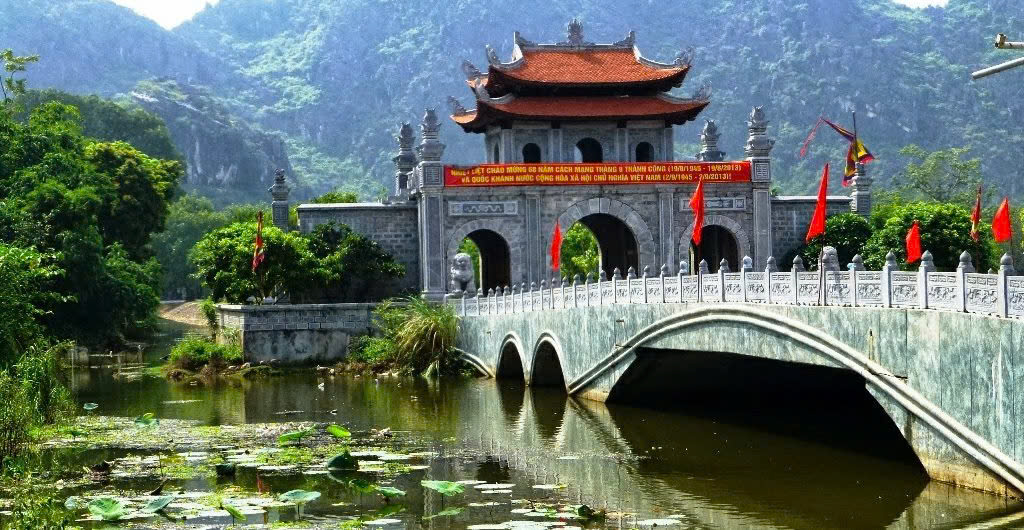 When you step onto the grounds of Hoa Lu Ancient Capital, you’re walking through more than a millennium of Vietnamese history. This is not just any temple complex; it’s the beating core of Vietnam’s first centralized feudal state and a national identity emblem.
Hoa Lu was established in the 10th century and became the political and cultural center of Vietnam under the Dinh and Le dynasties. It played a crucial role as the capital of Vietnam until the capital was moved to Thang Long (today is Hanoi). The Hoa Lu Temple complex, which is composed of several smaller temples, was constructed to honor the kings who ruled during this era, particularly King Dinh Tien Hoang and King Le Dai Hanh.
King Dinh Tien Hoang is one of the key historical figures associated with the temple. He was the founder of the Dinh dynasty and is credited with unifying Vietnam after a long period of fragmentation. His reign is considered a pivotal moment in Vietnamese history, and the Hoa Lu Temple was built as a tribute to his leadership and legacy.
King Le Dai Hanh, another ruler of the Le dynasty, also has his legacy honored at the Hoa Lu Temple. He was instrumental in securing Vietnam’s independence from foreign invasions, particularly from the Chinese. His contributions to the formation of a unified Vietnam are celebrated at this sacred site.
When you step onto the grounds of Hoa Lu Ancient Capital, you’re walking through more than a millennium of Vietnamese history. This is not just any temple complex; it’s the beating core of Vietnam’s first centralized feudal state and a national identity emblem.
Hoa Lu was established in the 10th century and became the political and cultural center of Vietnam under the Dinh and Le dynasties. It played a crucial role as the capital of Vietnam until the capital was moved to Thang Long (today is Hanoi). The Hoa Lu Temple complex, which is composed of several smaller temples, was constructed to honor the kings who ruled during this era, particularly King Dinh Tien Hoang and King Le Dai Hanh.
King Dinh Tien Hoang is one of the key historical figures associated with the temple. He was the founder of the Dinh dynasty and is credited with unifying Vietnam after a long period of fragmentation. His reign is considered a pivotal moment in Vietnamese history, and the Hoa Lu Temple was built as a tribute to his leadership and legacy.
King Le Dai Hanh, another ruler of the Le dynasty, also has his legacy honored at the Hoa Lu Temple. He was instrumental in securing Vietnam’s independence from foreign invasions, particularly from the Chinese. His contributions to the formation of a unified Vietnam are celebrated at this sacred site.
Exploring the Architecture of Hoa Lu Temple
The Unique Architecture
Although the old imperial palace complex no longer exists in its entirety, the remarkable reconstructions from the 17th century based on ancient foundations are what we find today at the temples. Over the ages, these buildings have seen many restorations; each dynasty adds architectural elements while maintaining the fundamental historical integrity. A monument to the cultural interactions that molded Vietnam’s identity, the architectural style combines Chinese inspirations with traditional Vietnamese design elements. The wooden buildings have elaborate carvings, sloping roofs with curved edges, and exquisite decorations highlighting the extraordinary workmanship of Vietnamese artists throughout many years.The Temple Complex
The Hoa Lu complex primarily features two magnificent temples dedicated to the emperors who ruled from this ancient capital, each with distinct characteristics and historical significance.King Dinh Temple
 Dedicated to Emperor Dinh Tien Hoang, this temple stands as a tribute to the founder of the Dinh Dynasty and unified Vietnam. As you enter, you’ll notice the three-section layout typical of Vietnamese temples – the anteroom for preparation, the incense-burning area for offerings, and the inner sanctuary housing the emperor’s statue.
The central shrine features a stone pedestal where Emperor Dinh sits majestically alongside his sons. The intricate carvings depicting dragons, phoenixes, and other mythical creatures symbolize royal power and divine protection. Look closely at the wooden columns – they tell stories of ancient Vietnam through their detailed artistry.
The temple’s peaceful atmosphere invites quiet reflection. Many Vietnamese visitors come to pay respects to this national hero who unified the country and established independence, values that remain deeply important in Vietnamese cultural identity.
Dedicated to Emperor Dinh Tien Hoang, this temple stands as a tribute to the founder of the Dinh Dynasty and unified Vietnam. As you enter, you’ll notice the three-section layout typical of Vietnamese temples – the anteroom for preparation, the incense-burning area for offerings, and the inner sanctuary housing the emperor’s statue.
The central shrine features a stone pedestal where Emperor Dinh sits majestically alongside his sons. The intricate carvings depicting dragons, phoenixes, and other mythical creatures symbolize royal power and divine protection. Look closely at the wooden columns – they tell stories of ancient Vietnam through their detailed artistry.
The temple’s peaceful atmosphere invites quiet reflection. Many Vietnamese visitors come to pay respects to this national hero who unified the country and established independence, values that remain deeply important in Vietnamese cultural identity.
King Le Temple
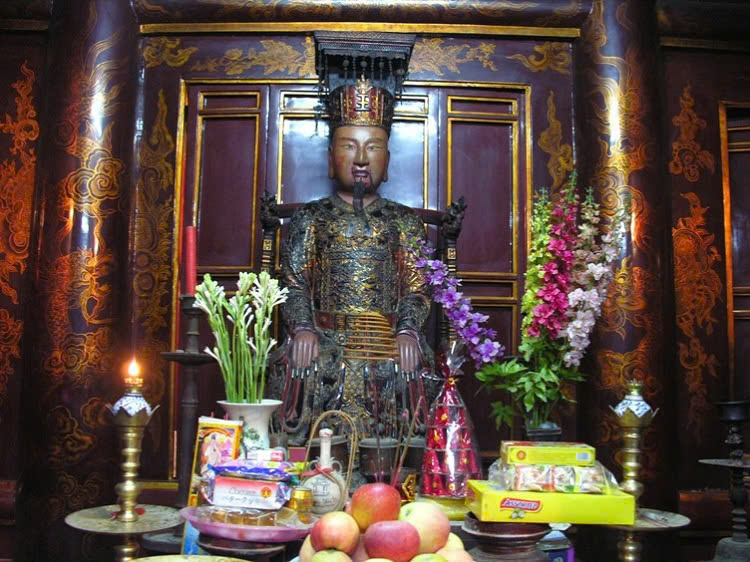 Just a short walk from King Dinh’s temple stands the equally impressive temple dedicated to Emperor Le Dai Hanh, who succeeded the Dinh Dynasty. Though similar in architectural style, this temple has its own unique features, including distinctive stone carvings and ceremonial items.
The temple honors Le Dai Hanh’s significant contributions to Vietnamese history, including his successful defense against Chinese invasions and his administrative reforms that strengthened the young Vietnamese state. Inside, you’ll find statues of the emperor alongside his queen and crown prince, symbolizing the continuity of leadership that was crucial during this formative period.
Just a short walk from King Dinh’s temple stands the equally impressive temple dedicated to Emperor Le Dai Hanh, who succeeded the Dinh Dynasty. Though similar in architectural style, this temple has its own unique features, including distinctive stone carvings and ceremonial items.
The temple honors Le Dai Hanh’s significant contributions to Vietnamese history, including his successful defense against Chinese invasions and his administrative reforms that strengthened the young Vietnamese state. Inside, you’ll find statues of the emperor alongside his queen and crown prince, symbolizing the continuity of leadership that was crucial during this formative period.
Hoa Lu Temple Tickets: Some Practical Tips
Ticket Prices for Hoa Lu Temple
To visit Hoa Lu Temple, visitors are required to purchase an entrance ticket. As of now, the price for a ticket to the temple is quite affordable, at 100.000 VNĐ for adults, making it accessible for both local and international tourists. The ticket generally includes access to both Hoa Lu Temple and the nearby Bai Dinh Pagoda, making it an excellent value for visitors.Where to Buy Tickets
Tickets can be purchased at the entrance of the temple or through local tour operators who offer guided visits to Hoa Lu and other nearby attractions. It’s advisable to book in advance, especially during peak tourist seasons, to avoid long lines and ensure entry.Best Time to Visit Hoa Lu Temple
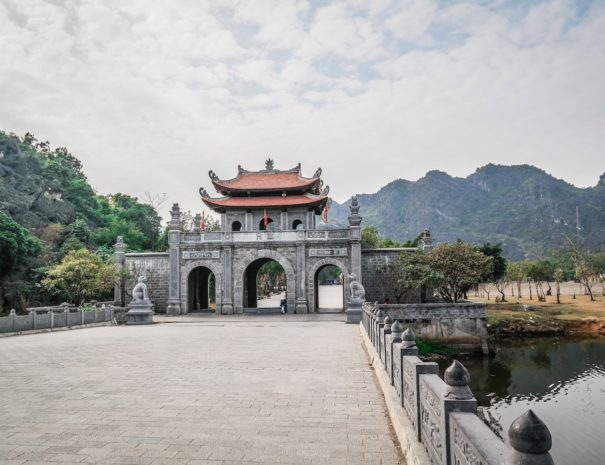 The ideal time to visit Hoa Lu Temple is during the dry season from November to April, when the weather is more predictable and comfortable for exploring. Early mornings (before 9:00 AM) offer the most tranquil experience before tour groups arrive. For photographers, the soft morning light creates magical effects on the ancient structures.
If possible, plan your visit to coincide with the Hoa Lu Festival in April (according to the lunar calendar) for a cultural immersion unlike any other. However, be prepared for larger crowds during this period.
The ideal time to visit Hoa Lu Temple is during the dry season from November to April, when the weather is more predictable and comfortable for exploring. Early mornings (before 9:00 AM) offer the most tranquil experience before tour groups arrive. For photographers, the soft morning light creates magical effects on the ancient structures.
If possible, plan your visit to coincide with the Hoa Lu Festival in April (according to the lunar calendar) for a cultural immersion unlike any other. However, be prepared for larger crowds during this period.
Things to Do Near Hoa Lu Temple
Bai Dinh Pagoda
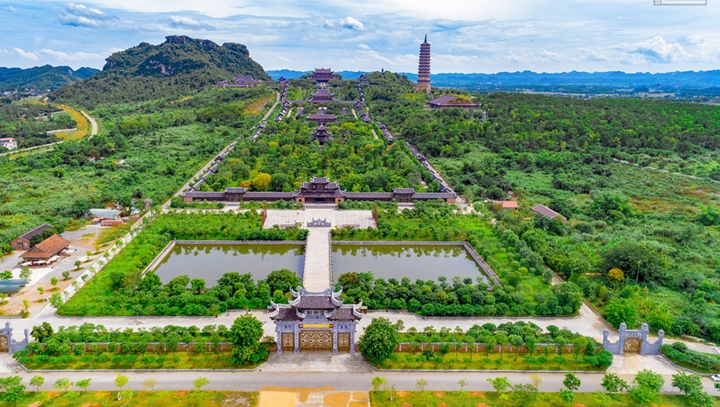 The limestone landscape of Ninh Binh province is home to Bai Dinh Pagoda, which is Vietnam’s biggest Buddhist complex and one of the most beautiful holy sites in Southeast Asia. With a temple from the 11th century in a cave on top of a mountain and a new property built in 2014, the complex perfectly combines old spiritual practices with modern beauty. At the entrance gate, a 13-story bell tower with a 36-ton bronze bell meets guests. The middle road winds through halls with 500 intricately carved Arhat sculptures in different poses and faces.
One of Vietnam’s biggest bronze Buddha statues, standing 10 meters tall, is the temple’s most important prize. It is sitting in meditation in the main hall, which is decorated with beautiful wood carvings and gold leaf. Pilgrims burn incense and monks sing sutras on the 700-hectare grounds. Soft mountain breezes carry the sounds of prayers through stone halls and lush gardens, making the experience more than just sightseeing.
The limestone landscape of Ninh Binh province is home to Bai Dinh Pagoda, which is Vietnam’s biggest Buddhist complex and one of the most beautiful holy sites in Southeast Asia. With a temple from the 11th century in a cave on top of a mountain and a new property built in 2014, the complex perfectly combines old spiritual practices with modern beauty. At the entrance gate, a 13-story bell tower with a 36-ton bronze bell meets guests. The middle road winds through halls with 500 intricately carved Arhat sculptures in different poses and faces.
One of Vietnam’s biggest bronze Buddha statues, standing 10 meters tall, is the temple’s most important prize. It is sitting in meditation in the main hall, which is decorated with beautiful wood carvings and gold leaf. Pilgrims burn incense and monks sing sutras on the 700-hectare grounds. Soft mountain breezes carry the sounds of prayers through stone halls and lush gardens, making the experience more than just sightseeing.
Trang An Scenic Landscape Complex
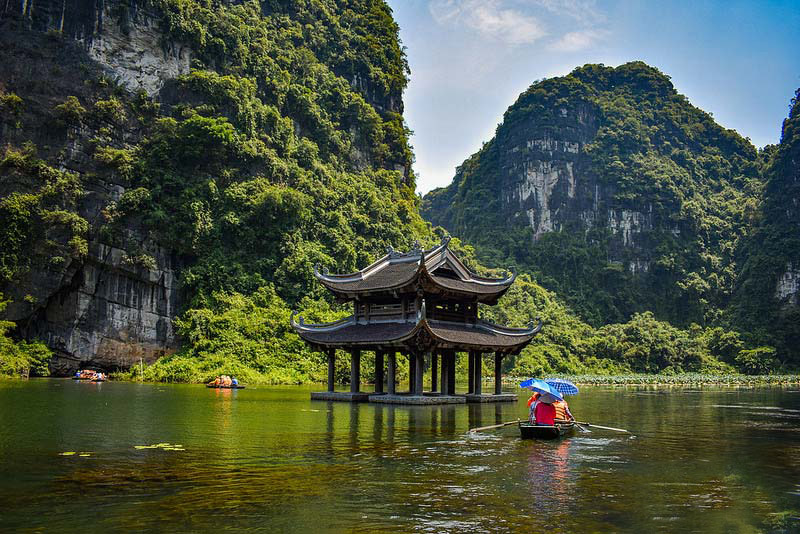 Approximately 15 kilometers from Hoa Lu Temple stands the crown jewel of Ninh Binh province—the Tràng An Landscape Complex. This UNESCO World Heritage Site represents a harmonious blend of cultural relics and spectacular natural beauty that rightfully earned its prestigious designation in 2014.
Unlike Tam Coc, where every boat travels the same routes, Trang An has several paths with various possibilities to discover, each highlighting special characteristics. While Route 2 stresses natural beauty and caves, Route 1 is often more culturally centered with temple visits. When you buy tickets, ask about the particular highlights of every path.
>>>> Check out our guide to Trang An Vietnam for your next Ninh Binh trip!
Approximately 15 kilometers from Hoa Lu Temple stands the crown jewel of Ninh Binh province—the Tràng An Landscape Complex. This UNESCO World Heritage Site represents a harmonious blend of cultural relics and spectacular natural beauty that rightfully earned its prestigious designation in 2014.
Unlike Tam Coc, where every boat travels the same routes, Trang An has several paths with various possibilities to discover, each highlighting special characteristics. While Route 2 stresses natural beauty and caves, Route 1 is often more culturally centered with temple visits. When you buy tickets, ask about the particular highlights of every path.
>>>> Check out our guide to Trang An Vietnam for your next Ninh Binh trip!
Thung Nham Bird Valley
 Nestled just 12 kilometers from Hoa Lu Temple lies one of Ninh Binh’s most remarkable yet often overlooked treasures—Thung Nham Bird Valley. This ecological sanctuary provides a perfect counterpoint to the historical grandeur of Hoa Lu, offering visitors an immersion into Vietnam’s natural splendor that complements their cultural exploration.
As you plan your journey through Ninh Binh province, consider adding this extraordinary bird sanctuary to your itinerary for a more complete understanding of the region’s diverse attractions. Check out our Ninh Binh Bird Call tour for a discovery journey to Ninh Binh’s wildlife!
Nestled just 12 kilometers from Hoa Lu Temple lies one of Ninh Binh’s most remarkable yet often overlooked treasures—Thung Nham Bird Valley. This ecological sanctuary provides a perfect counterpoint to the historical grandeur of Hoa Lu, offering visitors an immersion into Vietnam’s natural splendor that complements their cultural exploration.
As you plan your journey through Ninh Binh province, consider adding this extraordinary bird sanctuary to your itinerary for a more complete understanding of the region’s diverse attractions. Check out our Ninh Binh Bird Call tour for a discovery journey to Ninh Binh’s wildlife!
Tips for Visitors
To make the most of your visit to this historical treasure, consider these practical suggestions.Photography Opportunities
The photogenic quality of Hoa Lu Temple cannot be overstated. The contrast between ancient architecture and dramatic karst mountains creates stunning visual compositions. Early morning or late afternoon light casts beautiful shadows that highlight architectural details. For the best shots, consider bringing a wide-angle lens to capture the temples within their mountain backdrop.Cultural Etiquette When Visiting Hoa Lu Temple
Good cultural manners at Hoa Lu Temple enhance your trip and respect Vietnamese spiritual traditions. At the temples, local people and curious visitors engage in centuries-old spirituality. Vietnamese religious sites frown upon uncovered attire; hence, cover knees and shoulders. Remove your shoes and arrange them neatly at the temple door to keep the place pure and leave worldly concerns outside. During rituals or local prayer, walk deliberately within the temple, whispering or appreciating peaceful time. Photography is mostly permitted in key places; never pose with or touch Buddha statues or altar items without permission. Vietnamese culture calls for crossing the threshold in a small step over the threshold, where guardian spirits reside before crossing the gates. To help temple upkeep—which is voluntary—think about a little donation in the gift boxes. Cultural sensitivity transforms your trip from tourism into a deep encounter with Vietnam’s living spiritual tradition.Conclusion
 The Hoa Lu Temple represents Vietnam’s independence, persistence, and rich culture. More than simply historic architecture, these temples represent a nation that has survived decades of adversity. Whether you’re interested in history, architecture, or spirituality, Hoa Lu Temple provides a deep peek into Vietnam’s soul that will help you better understand this fascinating country.
>>>> Check out other Ninh Binh Attractions before planning your Ninh Binh itinerary!
Ready to discover? Book a Ninh Binh tour with us today to uncover the stories and significance of this remarkable landmark, and get a deeper understanding of Vietnam’s fascinating culture.
The Hoa Lu Temple represents Vietnam’s independence, persistence, and rich culture. More than simply historic architecture, these temples represent a nation that has survived decades of adversity. Whether you’re interested in history, architecture, or spirituality, Hoa Lu Temple provides a deep peek into Vietnam’s soul that will help you better understand this fascinating country.
>>>> Check out other Ninh Binh Attractions before planning your Ninh Binh itinerary!
Ready to discover? Book a Ninh Binh tour with us today to uncover the stories and significance of this remarkable landmark, and get a deeper understanding of Vietnam’s fascinating culture.
